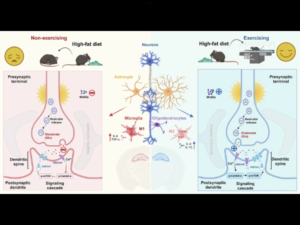Abstract: “Exercise enhances synaptic plasticity and alleviates depression symptoms, but the mechanism through which exercise improves high-fat diet-induced depression remains unclear. In this study, 6-week-old male C57BL/6J mice were administered a high-fat diet (HFD, 60% kcal from fat) to a HFD model for 8 weeks. The RUN group also received 1 h of daily treadmill exercise in combination with the HFD. Depressive-like behaviors were evaluated by behavioral assessments for all groups. The key mediator of the effect of exercise on high-fat diet-induced depressive-like behaviors was detected by RNA-seq. The morphology and function of the neurons were evaluated via Nissl staining, Golgi staining, electron microscopy and electrophysiological experiments. The results showed that exercise attenuated high-fat diet-induced depressive-like behavior and reversed hippocampal gene expression changes. RNA-seq revealed Wnt5a, which was a key mediator of the effect of exercise on high-fat diet-induced depressive-like behaviors. Further work revealed that exercise significantly activated neuronal autophagy in the hippocampal CA1 region via the Wnt5a/CamkII signaling pathway, which enhanced synaptic plasticity to alleviate HFD-induced depressive-like behavior. However, the Wnt5a inhibitor Box5 suppressed the ameliorative effects of exercise. Therefore, this work highlights the critical role of Wnt5a, which is necessary for exercise to improve high-fat diet-induced depression.”
Wu, J., Xu, H., Wang, S. et al. Regular exercise ameliorates high-fat diet-induced depressive-like behaviors by activating hippocampal neuronal autophagy and enhancing synaptic plasticity. Cell Death Dis 15, 737 (2024). https://doi.org/10.1038/s41419-024-07132-4

